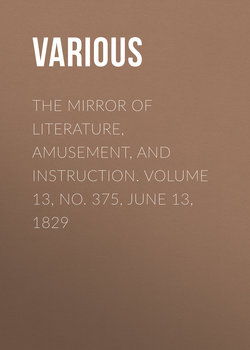Читать книгу The Mirror of Literature, Amusement, and Instruction. Volume 13, No. 375, June 13, 1829 - Various - Страница 1
CUMBERLAND TERRACE, REGENT'S PARK
ОглавлениеThe annexed Engraving completes our Series of Architectural Illustrations of the REGENT'S PARK, and is, withal the most magnificent Terrace in the circuit. It stands considerably above the road, and is approached by a fine carriage sweep, with handsome balustrades; below which, and level with the road, is the garden, or promenade for the residents of the Terrace.
The architect of Cumberland Terrace is Mr. Nash, who appears to have been so lavish of ornament, as to give the whole range the appearance of a triumphal temple. It consists of a centre and wings, connected by two handsome arches, which have a very pleasing and novel effect. The entrance, or ground story throughout, is rusticated, and in the principal parts or masses of the elevation, serves as a base or pediment for handsome Doric columns, above which is a balustrade, on which are placed allegorical figures of the Seasons, the Quarters of the Globe, the Arts and Sciences, &c. Each of these masses has a most imposing appearance, and bears four figures; the figures in the whole range amount to twenty-seven. Above the balustrade rises the attic story. The subordinate fronts of the residences are embellished with Doric pilasters.
Each arch consists of four handsome Doric columns, with an entablature, and blocking course.
The central portion of the terrace is in correspondent style with the wings; and consists of a splendid colonnade of twelve columns and an entablature. Above the attic story rises a pediment surmounted with figures of Painting, Architecture, and Sculpture. This pediment is filled with a basso-relievo, executed by J.H. Bubb, and representing Britannia crowned by Fame, and seated on a throne, the basis of which represents Valour and Wisdom. On one side, Literature, Genius, Manufacture, Agriculture, and Prudence, are bringing youth of different nations for instruction; and on the other side, the guardian-spirit of the Navy, surmounted by Victory, Navigation, Commerce, and Freedom, is extending her blessings to the Africans. The group is terminated on each side by Plenty. This is supposed to be the largest ornamental pediment in the kingdom, with the exception of that of the portico of St. Paul's, which only exceeds it by a few feet.
From the sweep of this terrace may be enjoyed a highly picturesque view of the park, with the crown of Primrose Hill in the distance.
At this close of the Series of Views, and as we are approaching the conclusion of our volume, it may not be amiss to recapitulate the several engravings, with their pages in the preceding and present volumes of the MIRROR, and the order in which they stand in the Regent's Park, which order circumstances have prevented our uniformly following in their publication: thus—
In this Series we have endeavoured to represent all the architectural beauties of the Park, and liable as are all of them to critical objection, they are extremely interesting for pictorial displays of the taste of this castle-building age.
THE KING'S STAG, &C
(To the Editor of the Mirror.)
As several of your correspondents have lately interested themselves in the sign of "The Cat and Fiddle;" a few observations may not be thought irrelevant, on the probable origin of the "King's Stag," a description of which, under the signature, Ruris, appeared in the MIRROR, of Saturday, the 30th ult. Its rise may, I conceive, with tolerable certainty, be traced to the stag said to have been taken in the Forest of Senlis, by Charles the Sixth, about whose neck was a collar, with the inscription, "Caesar hoc mihi donavit", which induced a belief that the animal had lived from the reign of some one of the twelve Caesars. This inscription also exists in the following form:—
"Tempore, quo Caesar Româ, dominatus in altâ
Aureolo jussit collum signare moniti;
Ne depascentem quisquis me gramina laedat,
Caesaris heu causâ, periturae parcere vitae."
which has been thus literally translated in nearly the same words quoted by Ruris—
"When Julius Caesar reigned king,
About my neck he put this ring,
That whosoever did me take,
Should spare my life for Caesar's sake."
It thus appears that Julius Caesar is gratuitously introduced by the English paraphrast, nothing appearing in the original inscription to determine its application, or render it more probable, that the reference should be to Julius Caesar, than to Domitian; and the two first lines given by Ruris, have evidently been introduced by way of transferring the subject to our own country.
Allow me before concluding this communication, one word in reply to E.D.'s observations on the "Cat and Fiddle." It is not impossible that some resemblance (though I am disposed to think it very trifling) may exist between the "tones of a flute" and those of "the human voice;" but I have yet to learn wherein consists the similarity of the notes of the clarinet and those of a "GOOSE;" neither do I imagine performers on the violin, (especially Italians,) will feel themselves obliged by E.D.'s comparison of their favourite instrument, to the vile squall of the feline race. On the whole, I should feel more disposed to concur with him who "has been led away by a love of etymology" that the "Cat and Fiddle" is an "anomalous" sign, and that "no two objects in the world have less to do with each other than a cat and a violin," than to adopt the opposite theories of E.D. or his predecessor, unless better supported than they are at present. IOTA.
